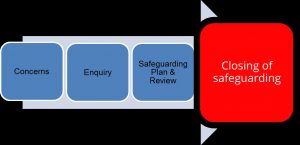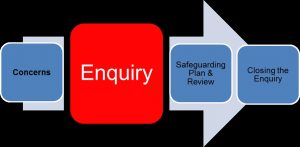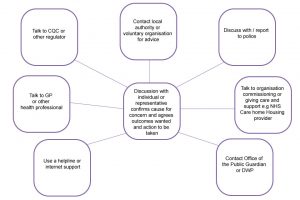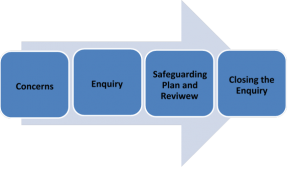August 2024: This new chapter, explains the inherent jurisdiction and how it can be used to safeguard adults who the Courts describe as ‘capacitous but vulnerable’.
1. Introduction
The term ‘inherent jurisdiction’ refers to the High Court’s ability to make declarations, orders and grant injunctions in situations where there is no statutory power to intervene to protect an adult. It has been described by courts as a ‘safety net’ as it allows them to intervene where there is no other legal avenue available. It can be used in situations not covered by existing legislation, such as the Mental Capacity Act 2005 (MCA), Mental Health Act 1983 or legislation in relation to domestic abuse, coercive and controlling behaviour or forced marriage.
However, it cannot be used in a way that would directly contradict any legislation.
It can be used to fill a gap where there is no existing applicable legislation, but not as a way of getting around or circumventing existing legislation.
In all cases, it is necessary to first consider what, if any, other legislative mechanisms exist. It is only after considering whether any existing legislation covers the position. that it can be clear whether there is a gap to be filled, and whether recourse to the inherent jurisdiction is necessary.
Any legal professions or organisation with legal standing can bring an application to the High Court. This includes local authorities, NHS trusts and Integrated Care Boards.
2. Scope of the Inherent Jurisdiction
The inherent jurisdiction can be used to fill a legal ‘gap’ and so can cover a variety of scenarios. By its very nature, there is no legislation setting out the precise remit of the inherent jurisdiction, and it is instead developed on an ongoing basis by way of case law. For this reason, legal advice must be obtained as soon as possible in circumstances where it is thought that an application to the High Court may be required.
One of the main areas where the inherent jurisdiction has been used in recent cases is in situations where an adult is not able to freely make their own decisions, but this is not as a result of mental incapacity. In these situations, the courts have used the term ‘capacitous but vulnerable’ which means the person has mental capacity but is vulnerable in some other way.
For example, an adult may be subject to external influences, such as coercion or undue influence from another person, which limits their ability to make their own decisions freely. The adult’s decision-making is therefore impaired, and they are unable to make their own choice freely, but this is because of coercion or undue influence, rather than because of a disturbance or impairment in the functioning of their mind or brain, as required by the MCA (see Mental Capacity chapter).
Case law has established that a person may have physical or cognitive impairments but those will not necessarily, on their own, mean that they are ‘at risk’ so as to make use of the inherent jurisdiction necessary. On the other hand, a person may have no physical or cognitive impairment but is still ‘at risk’ as a direct result of the coercion or abuse from another person, and so may come within the remit of the inherent jurisdiction. A family member may use influence over another family member, but for the situation to come within the inherent jurisdiction, the influence must be ‘undue’ or ‘coercive’ so the adult is incapable of making their own decisions.
The inherent jurisdiction may also be used in situations where action is required to safeguard an adult from risks from themselves, such as self-neglect, where the adult has mental capacity and so action under legislation is not an option, but the risks they cause to themselves are so great that court intervention is necessary (see Self Neglect Guidance).
It may also be used where an adult lacks capacity but the situation is not covered by the Mental Capacity Act, for example where the adult falls into a legislative ‘gap’ between the Mental Health Act 1983 and the Mental Capacity Act 2005.
3. Types of Order
Before making any order, the court must be satisfied that it is necessary and proportionate to do so. The order must be reasonable and proportionate to the circumstances and not go beyond the minimum necessary to safeguard the adult.
Orders may or may not be time-limited.
Orders may require someone to take specified actions (such as to allow access to an adult) or may set out what someone must not do (such as to threaten or assault an adult).
Types of orders which may be made under the inherent jurisdiction include (but are not limited to) orders:
- allowing social care professionals to gain access to adults where there are safeguarding concerns but where, for example, another person is denying or restricting access to the person about whom there are concerns and there are no grounds for an order under existing legislation;
- freezing assets to prevent the adult’s money or property being wrongly transferred or spent;
- recovering money and / or property belonging to the adult which has already been disposed of;
- overturning a decision about the transfer of money belonging to the adult which has already been made.
Orders made under the inherent jurisdiction can be directed either at the adult or at the person who is coercing them.
For example, orders have been made against the person coercing the adult preventing them from:
- refusing access to the adult by health and social care professionals;
- not allowing the adult to have contact with family and / or friends;
- behaving in an aggressive and / or confrontational manner to health and social care staff;
- interfering in the provision of care and support to the adult;
- assaulting or threatening the adult;
- seeking to persuade or coerce the adult into transferring ownership of property (such as money or their home);
- trying to persuade or coerce the adult into moving into a care home or nursing home;
- behaving in a way towards the adult which is degrading or coercive, such as having unreasonable restrictions on which rooms in the house the adult is allowed in, or punishing the adult, particularly if those punishments are degrading or otherwise humiliating.
Case law has established that, in general, it is better for orders to be made in relation to the person coercing the adult, rather than directed at the adult themself. This is because such an order is likely to be less of a restriction for the adult, and so more proportionate and more likely to promote their independence and empowerment.
Where an order is requested which is directed at the adult, the High Court* has stated that, in order to satisfy the requirements for the order to be both necessary and proportionate, the applicant should be able to demonstrate (with supporting evidence) that they have considered:
- whether the adult will be informed about the order;
- whether the adult is likely to understand the purpose of the order;
- whether the adult will appreciate the impact if the order is breached or broken.
*Redcar & Cleveland Borough Council v PR [2019] EWHC 2305 (para. 46)
See Appendix 1: Case Law Regarding Mental Health and Inherent Jurisdiction and Appendix 2: Deprivation of Liberty safeguards and inherent jurisdiction.
4. Legal Summary of the Inherent Jurisdiction
The inherent jurisdiction is the High Court’s jurisdiction or power to protect ‘incompetent’ and also ‘vulnerable’ adults. Usually this is where a person has mental capacity, and therefore the MCA cannot be used. It is a jurisdiction that can only be used by the High Court, not the Court of Protection (CoP).
The legal standard is set out by Munby J, Re SA (Vulnerable Adult with Capacity: Marriage) [2005] EWHC 2942 (Fam), at 76-83
McFarlane LJ in A Local Authority v DL & Ors [2012] EWCA Civ 253 at paras 54, 62 described it as:
“The High Court has jurisdiction over those who, if not incapacitated, are reasonably believed to be i) under constraint, or ii) subject to coercion or undue influence, or iii) other disabling circumstance: “some other reason deprived of capacity to make relevant decision, disabled from making a free choice, or incapacitated or disabled from giving or expressing a real and genuine consent”:
4.1 Basic principles
To be able to use the inherent jurisdiction, the proposed intervention must be necessary and proportionate.
The Court will first attempt to use inherent jurisdiction to assist creative decision-making, rather than taking a decision for the adult: LBL v RYJ and VJ [2010] EWHC 2665 (COP) “facilitative, rather than dictatorial, approach of the court”;
A Local Authority v DL & Ors [2012] EWCA Civ 253 at para 68 per McFarlane LJ noted that inherent jurisdiction is not limited solely to affording a vulnerable adult a temporary safe space’ within which to make a decision free from any alleged source of undue influence. The Court may, in appropriate cases, impose long-term injunctive relief to protect the vulnerable adult.
5. Practice Guidance for using the Inherent Jurisdiction
5.1 Documents required
The relevant legal team will make the application to the High Court using a Part 8 claim form and will include:
- draft order;
- witness statement;
- source documents.
5.2 Grounds / what to show
- Explanation of how the court has jurisdiction; for example coercion; undue influence; other disabling influences.
- That the proposed intervention is necessary.
- That the proposed intervention is proportionate; this should include the alternative options which have been considered.
5.3 Legal process
- The application is filed in the Family Division of the High Court.
Points to consider / discuss include:
- Does the application need to be lodged without notice being given to those who are alleged to be controlling the person?
- Is it urgent?
- If it is not urgent, should the application be started with a request for directions (which is when the court gives instructions to the parties on how they are to prepare the case) ?
- Are there any interim measures required?
- Does there need to be any fact-finding hearing?
5.4 Where a person has borderline mental capacity
If mental capacity is uncertain at the start of the proceedings, there are two options:
- Commence in High Court and explain why;
- Commence in the CoP and transfer to the High Court if required.
If urgent action is required, it is best to start proceedings in the High Court.
6.Further Reading
6.1 Relevant chapters
6.2 Relevant information
Guidance Note: Using the Inherent Jurisdiction in Relation to Adults (39 Essex Chambers)
Gaining access to an adult suspected to be at risk of neglect or abuse (SCIE)
Appendix 1: Case Law Regarding Mental Health and Inherent Jurisdiction
Redcar & Cleveland Borough Council v PR [2019] EWHC 2305 (para. 46)
The facts centred around a capacitous (person with mental capacity) but vulnerable 32-year-old woman who was living with her parents. Her mental health deteriorated, and she was admitted to hospital. While she was in hospital, she made allegations about her father. The woman’s mental health improved, and when she was well enough to be discharged from hospital, the local authority became concerned that she was planning to return home to live with her parents. The authority issued an application under the inherent jurisdiction for protective orders.
In its judgment at paragraph 46, Cobb J observed that “before a local authority made an application under the court’s inherent jurisdiction, which was designed to regulate the conduct of a subject by way of injunction, particularly where mental illness or vulnerability was an issue, it should be able to demonstrate (and support with evidence) that it had appropriately considered:
- whether the person was likely to understand the purpose of the injunction;
- (ii) would receive knowledge of the injunction; and
- (iii) would appreciate the effect of breach of that injunction. If the answer to any of these questions was in the negative, the injunction was likely to be ineffectual and should not be applied for or granted since no consequences could flow from the breach”.
There is not yet clear case-law as to the extent to which orders may be made under the inherent jurisdiction which would have the effect of depriving the adult of their liberty.
Appendix 2: Deprivation of Liberty Safeguards and Inherent Jurisdiction
The use of the inherent jurisdiction to authorise a deprivation of liberty must comply with article 5 of the European Convention on Human Rights and is illustrated in the case of NHS Trust v Dr A [2013] COPLR 605.
The facts involved an Iranian doctor, Dr A, who went on hunger strike to recover his passport that had been confiscated by the UK Borders Agency following his failed claims for asylum. He suffered from a delusional disorder which impaired the functioning of his brain by affecting his ability to use or weigh up information relevant to his decision whether to accept nourishment. It was in his best interests for the court to make an order permitting the forcible administration of artificial nutrition and hydration. This treatment would involve deprivation of liberty, but Dr A was ineligible to be deprived of his liberty under the MCA because he was already detained under the MHA. A legislative gap had occurred; as he could not be given the treatment under the MHA because it was not for a mental disorder, but a physical disorder.
2.1 Issues and judgement
The legal question was whether the High Court had power to make order under inherent jurisdiction to authorise forcible feeding of an incapacitated adult where a deprivation of liberty could not be authorised under MCA 2005 section16(A)(1): “If a person is in ineligible to be deprived of liberty by this Act, the court may not include in a welfare order provision which authorises the person to be deprived of his liberty”. It was not disputed that subjecting Dr A to forcible feeding amounted to a deprivation of liberty, but the difficulty was identifying how that deprivation was to be authorised in law.
The solution to the problem was to authorise treatment under the High Court’s inherent jurisdiction as being in Dr A’s best interests (paragraphs 94 & 96) In NHS Trust v Dr A, the Courts firmly established that the inherent jurisdiction was available to provide a remedy particularly, when none was available under the comprehensive MCA 2005 legislation that would meet the care of such a mentally incapacitated adult.
“[96] In all the circumstances, I hold that this court has the power under its inherent jurisdiction to make a declaration and order authorising the treatment of an incapacitated adult that includes the provision for the deprivation of his liberty provided that the order complies with Art 5. Unless and until this court or another court clarifies the interpretation of s 16A of the MCA, it will therefore be necessary, in any case in which a hospital wishes to give treatment to a patient who is ineligible under s 16A, for the hospital to apply for an order under the inherent jurisdiction where the treatment (a) is outside the meaning of medical treatment of the MHA and (b) involves the deprivation of a patient’s liberty.”
This decision illustrates how the inherent jurisdiction is a flexible legal tool to plug legislative gaps. It can not only protect adults who fall outside the scope of the MCA but can also be raised for those persons who need to be deprived of liberty and fall between the provisions of the MHA and MCA.









